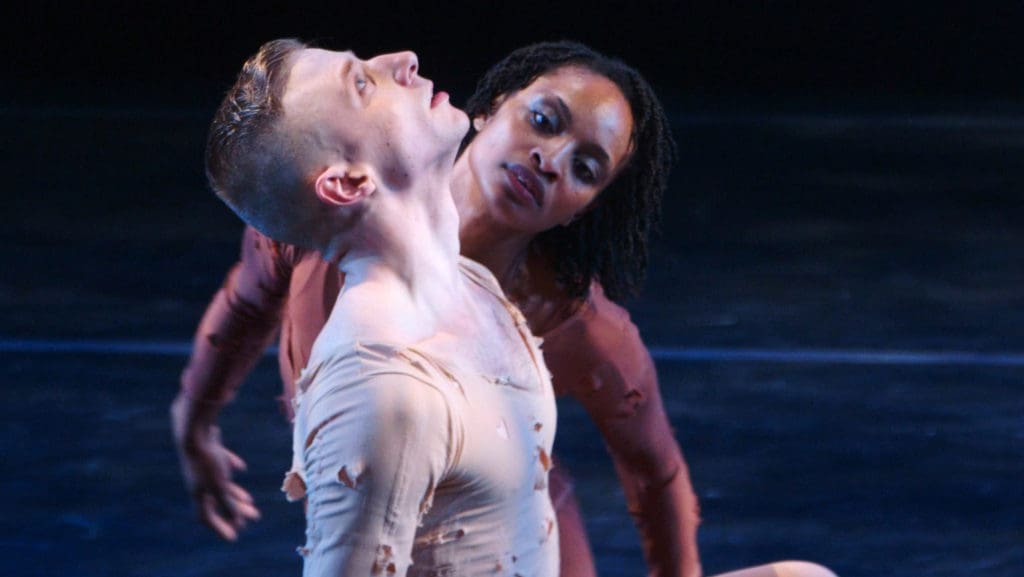
Dance is a universal language. Or as choreographer Merce Cunningham put it: “If the dancer dances, everything is there.” That quote gives the title to directors Lise Friedman and Maia Wechsler’s new documentary, If the Dancer Dances, which centers around a re-staging of Cunningham’s 1968 piece, RainForest. Assembled from from a mix of rehearsal and archival footage, it follows choreographer Stephen Petronio’s company in the months leading up to that performance in March of 2016 at New York City’s Joyce Theater. And while the film may work best for those already interested in dance, it’s also a detailed examination of the artistic process that should entertain any viewer who just likes to watch artists work.
As Petronio explains at the film’s beginning, after Cunningham’s death in 2009 and his mentor Trisha Brown falling ill, he was driven to have his company perform a piece that he didn’t create for the first time because “the adult world as [he] knew it cracked.” Petronio is clearly in awe of the piece, which he calls, “one of those crazy collaborations that set the clock forward,” and it’s easy to understand why. Not only did it feature Cunningham’s choreography, it also has a set of floating silver pillow balloons by Andy Warhol, music by David Tudor and costumes by Jasper Johns. It’s quite a legacy to live up to and from the beginning, both Petronio and his dancers are painfully aware of that pedigree.
The pressure only intensifies when Petronio brings in three dancers who worked with Cunningham to teach the company the piece: Meg Harper, Rashaun Mitchell and Andrea Weber. While Harper brings the gravitas as one of the piece’s original dancers and Mitchell brings a modern perspective as the dancer who took over Cunningham’s role in RainForest after his death, Weber is perhaps the most compelling figure throughout. As Petronio notes when he first talks about seeking out various members of Cunningham’s company, “…the amazing thing about dance is that it gets passed from one body and one soul to another,” and because video is “flat,” he goes to the original dancers for their “muscular memory.” Weber is the embodiment of that memory and the pressure the dancers feel to recreate it. She dives right in on the first rehearsal and the movie follows suit, leaving both the viewer and the dancers to catch up. It’s a risky move by Friedman and Wechsler that could alienate viewers, but it sets a pace and a tone that perfectly conveys the stakes.
Weber starts by making the Petronio dancers do back exercises to strengthen their spines. More then just an unintentional metaphor, it’s a necessary learning tool because, as one of Petronio’s dancer’s Dava Fearon, who struggles with the movement’s constant control, explains it, the “initiation points” for the movement in Cunningham’s work come from the core and back rather than limbs as in Petronio’s work. As Gus Solomons Jr., another original performer of RainForest who only consults after the initial teaching process puts it, “In a sense, Stephen’s work can’t stop … in a sense, Merce’s work can always stop.”
Still, despite those explanations, there and elsewhere, the film is so filled with technical dance discussions that it runs the risk of being difficult to follow for those not already interested in dance. Friedman and Wechsler mitigate the problem by always pairing the technical notes with the movements they refer to—both in the current moment and in archival footage. One of the most striking moments comes when we watch Andrea and Rashaun teaching the dancers to perform a brief passage and editor Mary Manhardt cuts between the current rehearsal and one of the times they performed RainForest together in 2011. It’s a moment that not only allows the audience to understand what their critiques mean, but gives a fuller context for what the piece means to them.
Indeed, while the film is technically about Petronio’s staging of RainForest, Friedman and Wechsler also give the viewer a full picture of the history surrounding Cunningham. While scenes where former Cunningham dancers explain that Cunningham rarely ever explained the emotion behind the moves and almost never rehearsed his dancers with music are interesting (and emphasize just how difficult Petronio’s dancers must work to connect with the piece), it’s the film’s willingness to question Cunningham’s legacy that’s most compelling.
As Fearon notes late in the film, she is the first black woman to ever perform RainForest professionally and while Friedman and Wechsler could easily avoid the implications to maintain a glowing picture of Cunningham, they don’t. As Solomons Jr. notes, “Merce fell in love with body types or body parts,” so certain traits recurred. He “always had Viola Farmer feet in the company,” he always looked for men who could leap high and after casting Solomons Jr. for that exact ability, it became a tradition to have one black man in the company. As he puts it, Cunningham, “never saw a black woman who fit his image of what women dancers were,” and while the potentially racist implications of that assertion remain unexamined, it’s hard to miss the point as we see archival footage of Cunningham rehearsing exclusively with tall, thin, white women.
Despite all of its strengths, If the Dancer Dances may simply be too esoteric for viewers who aren’t already interested in dance. It’s very technical, and after spending 83 minutes worrying about whether Petronio’s company will pull off RainForest, it can feel a little disappointing to not see the piece in full. However, despite how specific Friedman and Wechsler’s film can be, they manage to convey that information in such a compelling, digestible way that it’s hard to imagine any viewer not finding something to connect with. Dance is a universal language, after all.

